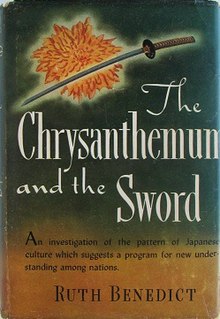The Chrysanthemum and the Sword

First edition
|
|
| Author | Ruth Benedict |
|---|---|
| Original title | The Chrysanthemum and the Sword: Patterns of Japanese Culture |
| Country | United States |
| Language | English |
| Subject | National Characteristics, Japanese |
| Genre | History/Anthropology |
| Publisher | Houghton Mifflin |
|
Publication date
|
1946 |
| Media type | Print (Hardcover) |
| Pages | 324 pp (first edition) |
| ISBN | |
| OCLC | 412839 |
| 952 19 | |
| LC Class | DS821 .B46 1989 |
The Chrysanthemum and the Sword: Patterns of Japanese Culture is a 1946 study of Japan by American anthropologist Ruth Benedict. It was written at the invitation of the U.S. Office of War Information, in order to understand and predict the behavior of the Japanese in World War II by reference to a series of contradictions in traditional culture. The book was influential in shaping American ideas about Japanese culture during the occupation of Japan, and popularized the distinction between guilt cultures and shame cultures.
Although it has received harsh criticism, the book has continued to be influential. Two anthropologists wrote in 1992 that there is "a sense in which all of us have been writing footnotes to [Chrysanthemum] since it appeared in 1946". The Japanese, Benedict wrote, are
both aggressive and unaggressive, both militaristic and aesthetic, both insolent and polite, rigid and adaptable, submissive and resentful of being pushed around, loyal and treacherous, brave and timid, conservative and hospitable to new ways...
The book also affected Japanese conceptions of themselves. The book was translated into Japanese in 1948 and became a bestseller in the People's Republic of China when relations with Japan soured.
This book which resulted from Benedict's wartime research, like several other OWI wartime studies of Japan and Germany, is an instance of "culture at a distance," that is, study of a culture through its literature, newspaper clippings, films and recordings, and extensive interviews with German-Americans or Japanese-Americans. These techniques were necessitated by anthropologists' inability to visit Nazi Germany or wartime Japan. As one later ethnographer pointed out, however, although "culture at a distance" had the "elaborate aura of a good academic fad, the method was not so different from what any good historian does: to make the most creative use possible of written documents." These anthropologists were attempting to understand the cultural patterns that might be driving the aggression of once friendly nations, and hoped to find possible weaknesses or means of persuasion that had been missed.
...
Wikipedia
